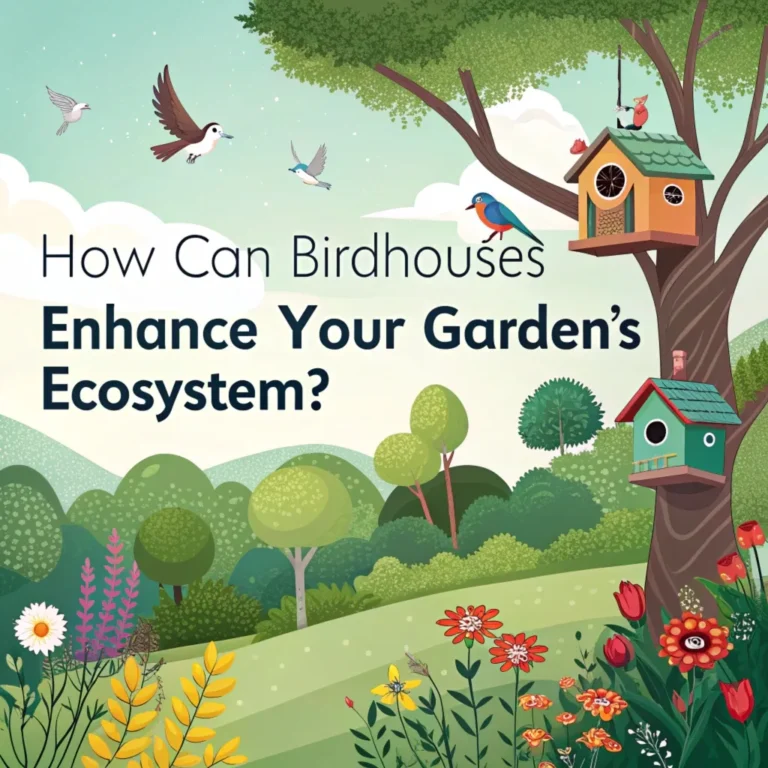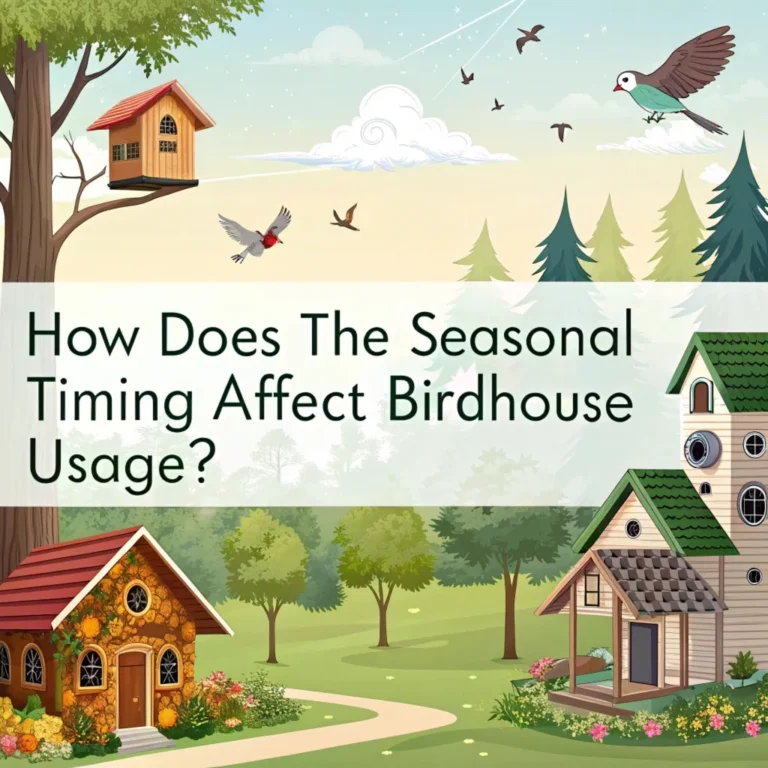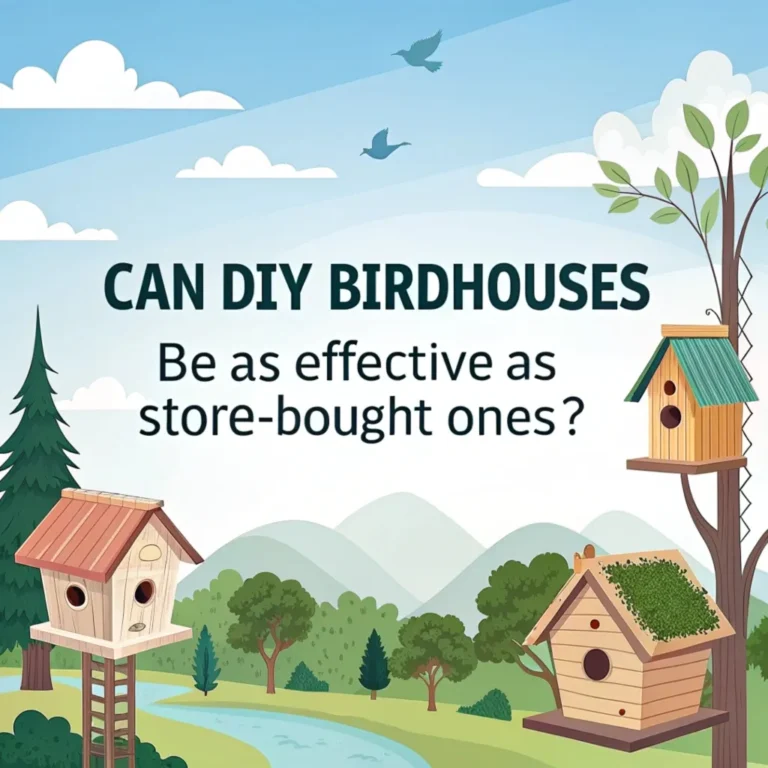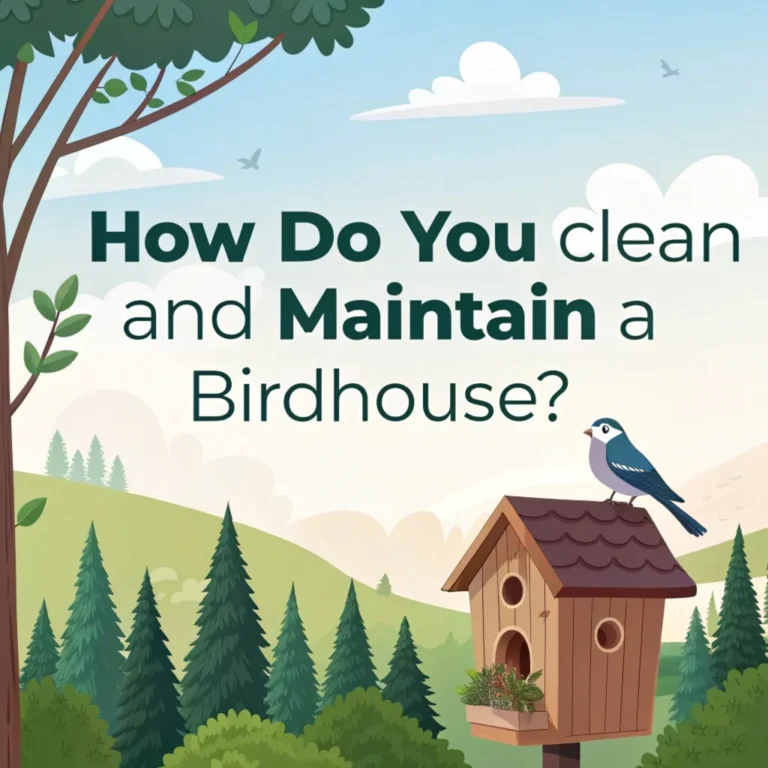Which Birdhouse Designs are Best for Specific Birds? A Complete Guide
Are you eager to attract specific bird species to your backyard? Choosing the right birdhouse design can make all the difference. Birds are not only delightful to watch but also play a crucial role in maintaining ecological balance.
However, each bird species has its own unique nesting preferences, and providing the perfect birdhouse can help them thrive. From the size of the entrance hole to the materials used, every detail matters when it comes to making birds feel at home.
In this guide, we’ll explore birdhouse designs tailored for specific birds, ensuring you can create a safe and welcoming environment for your feathered friends.

Key Takeaways: In a Nutshell
- Birdhouses must cater to specific species: Different birds have unique requirements for dimensions, entrance hole sizes, and materials.
- Materials matter: Use untreated wood like cedar or pine for durability and safety.
- Placement is key: Mount birdhouses at appropriate heights and locations to ensure comfort and protection from predators.
- Ventilation and drainage: Proper air circulation and water drainage prevent overheating and keep nests dry.
- Predator protection: Features like no perches and metal guards around entrance holes enhance safety.
- Species-specific examples:
- Eastern Bluebirds: Require 1.5-inch entrance holes and predator guards.
- Purple Martins: Prefer multi-compartment houses or gourd clusters.
- Wrens: Opt for small houses with 1 1/8-inch entrance holes.
- Robins: Nest on open platforms rather than enclosed boxes.
- Customization is crucial: Each bird species has distinct preferences, so understanding their needs ensures successful nesting.
Now that we’ve covered the essentials, let’s delve deeper into the best birdhouse designs for different bird species.
Why Birdhouse Design Matters
Birds are selective about their nesting sites, often rejecting poorly designed houses. The right design ensures:
- Comfortable nesting conditions.
- Protection from predators and harsh weather.
- Encouragement of natural behaviors, such as feeding and raising chicks.
Creating the perfect birdhouse is not just about aesthetics; it’s about understanding the specific needs of different bird species. A well-designed birdhouse can significantly impact the survival and breeding success of birds in your area.
By providing a safe and comfortable nesting space, you’re contributing to local biodiversity and helping maintain healthy bird populations.
Proper birdhouse design also plays a crucial role in bird conservation efforts. As natural habitats continue to shrink due to urbanization, providing artificial nesting sites becomes increasingly important.
By offering species-specific birdhouses, you’re creating vital refuges for birds that might otherwise struggle to find suitable nesting locations. This simple act can have a profound impact on local ecosystems and help preserve bird species for future generations to enjoy.
Eastern Bluebird Birdhouses

Eastern Bluebirds are cavity nesters that thrive in open areas. Their ideal birdhouse includes:
- Dimensions: 4×4-inch floor, 12 inches tall.
- Entrance hole: 1.5 inches in diameter.
- Materials: Untreated cedar or pine wood for insulation and durability.
- Features:
- Predator guards around the entrance hole.
- Ventilation holes to prevent overheating.
- Drainage holes to keep nests dry.
Placement Tip: Mount the house on a pole at least 5 feet above ground, facing an open field.
Eastern Bluebirds are a favorite among birdwatchers due to their vibrant blue plumage and melodious songs. These cavity-nesting birds have faced population declines in the past due to habitat loss and competition from invasive species.
By providing specially designed birdhouses, we can help support their recovery and ensure their continued presence in our landscapes.
The specific design requirements for Eastern Bluebird houses are crucial for their nesting success. The 1.5-inch entrance hole is particularly important as it allows bluebirds to enter while excluding larger competitors like starlings.
Additionally, the untreated wood provides natural insulation, helping to regulate temperature inside the nest box. By following these design guidelines, you can create an ideal nesting environment that will attract and support Eastern Bluebirds in your area.
Chickadee-Friendly Birdhouses
Chickadees are small birds that prefer compact spaces. Their perfect nesting box should have:
- Dimensions: 4×4-inch floor, 8 inches tall.
- Entrance hole size: 1 1/8 inches in diameter (small enough to exclude larger birds).
- Materials: Cedar or untreated pine wood.
- Features:
- Hinged roofs for easy cleaning.
- No perches to deter predators.
Placement Tip: Hang or mount the house on a tree trunk or pole within dense vegetation.
Chickadees are charming, acrobatic birds that bring life and energy to any backyard. These small, curious birds are known for their distinctive “chick-a-dee-dee-dee” call and their ability to hang upside down while foraging.
Providing a well-designed birdhouse for chickadees can encourage these delightful birds to nest in your yard, offering you a front-row seat to their fascinating behaviors.
The compact design of chickadee birdhouses reflects their natural nesting preferences. In the wild, chickadees often choose small cavities in trees, so a snug nesting box mimics their ideal habitat.
The absence of perches is a crucial safety feature, as it prevents larger predatory birds from gaining easy access to the nest. By offering these specially designed houses, you’re not only attracting chickadees but also providing them with a safe haven for raising their young.
Purple Martin Colonies

Purple Martins are social birds that nest in colonies. Their housing needs include:
- Design: Multi-compartment houses or clusters of hanging gourds.
- Dimensions per compartment: 6×6 inches with a height of 6 inches.
- Entrance hole size: Approximately 2 1/8 inches in diameter.
- Materials: Aluminum or white-painted wood/plastic to reflect heat.
Placement Tip: Install at least 40 feet away from trees or buildings, at a height of 10–20 feet.
Purple Martins are unique among North American swallows in their almost complete dependence on human-provided housing east of the Rocky Mountains.
These gregarious birds have a long history of nesting near human settlements, dating back to Native American times when gourds were first used to attract them. Today, providing suitable housing for Purple Martins is not just a hobby but a crucial conservation effort.
The colonial nesting habits of Purple Martins require a different approach to birdhouse design. Unlike solitary nesters, these birds prefer to live in close proximity to others of their species.
The multi-compartment houses or gourd clusters mimic their natural nesting conditions and encourage the formation of thriving colonies.
The specific placement requirements are essential for the birds’ safety, allowing them easy access to their nests while keeping them away from potential predators lurking in nearby trees or buildings.
Wren-Specific Birdhouses
Wrens are adaptable but prefer compact spaces. Their ideal house includes:
- Dimensions: 4×4-inch floor, 8 inches tall.
- Entrance hole size: 1 1/8 inches in diameter.
- Materials: Cedar or redwood for longevity.
- Features:
- Ventilation holes for airflow.
- Hinged roof for easy cleaning.
Placement Tip: Place in shaded areas close to shrubs or trees.
Wrens are known for their energetic behavior and beautiful, complex songs. These small but mighty birds have a reputation for being feisty and territorial, often filling multiple nest boxes in their territory with twigs to prevent other birds from using them.
Providing a well-designed wren house can help channel this behavior constructively and encourage wrens to nest in your yard.
The compact design of wren birdhouses caters to their preference for snug nesting sites. In nature, wrens often choose small cavities or crevices for their nests. The small entrance hole is crucial, as it allows wrens to enter while excluding larger birds that might compete for the nesting space.
By placing these houses in shaded areas near shrubs or trees, you’re creating an ideal environment that mimics the wrens’ natural habitat preferences, increasing the likelihood of attracting these charming birds to your yard.
Nuthatch Nest Boxes
Nuthatches prefer secluded spaces with specific features:
- Dimensions: Similar to wren houses (4×4-inch floor, up to 10 inches tall).
- Entrance hole size: Around 1.25 inches in diameter.
- Materials: Cedar or redwood wood for natural insulation.
- Features:
- Predator guards around entrances.
- Drainage and ventilation holes.
Placement Tip: Mount on tree trunks at heights between 5–15 feet.
Nuthatches are fascinating birds known for their ability to climb headfirst down tree trunks, a unique behavior among birds. These agile acrobats are cavity nesters in the wild, often using abandoned woodpecker holes or natural tree cavities.
By providing specially designed nest boxes, we can offer nuthatches alternative nesting sites, especially in areas where natural cavities might be scarce.
The design of nuthatch birdhouses closely mimics their natural nesting preferences. The cedar or redwood construction provides excellent insulation, helping to maintain a stable temperature inside the nest box.
The predator guards around the entrance are particularly important for nuthatches, as these birds often enlarge the entrance holes of their nests, potentially making them vulnerable to predators.
By mounting these houses on tree trunks, we’re creating an environment that feels natural and secure for these charming birds.
Woodpecker Birdhouses
Woodpeckers require larger houses with rough interiors for climbing. Their ideal design includes:
- Dimensions: Floor size of at least 6×6 inches; height of up to 14 inches.
- Entrance hole size: Approximately 1.5 inches in diameter (varies by species).
- Materials: Rough-cut cedar or exterior-grade plywood.
Placement Tip: Install on tree trunks at heights between 10–20 feet.
Woodpeckers are remarkable birds known for their distinctive drumming and their ability to excavate their own nesting cavities. While many woodpeckers prefer to create their own homes, some species will readily use man-made birdhouses if they meet specific criteria.
Providing suitable nesting boxes for woodpeckers can be particularly beneficial in areas where large, dead trees (their preferred natural nesting sites) are scarce.
The design of woodpecker birdhouses reflects the unique needs of these birds. The larger dimensions accommodate their size, while the rough interior allows them to climb easily, mimicking the texture of a natural tree cavity.
The specific entrance hole size is crucial, as it varies depending on the woodpecker species you’re trying to attract.
By installing these houses on tree trunks at the recommended height, you’re creating an environment that feels natural and secure for woodpeckers, increasing the chances of successful nesting.
Swallow Nesting Boxes
Swallows prefer houses near water sources. Their requirements include:
- Dimensions: Floor size of about 5×5 inches; height of up to 10 inches.
- Entrance hole size: Between 1.375–1.5 inches in diameter.
- Materials: Untreated wood like cedar or pine.
Placement Tip: Position near water bodies at heights of around 6–15 feet.
Swallows are graceful aerial insectivores, known for their agility in flight and their habit of swooping low over water to catch insects.
These social birds often nest in colonies, and providing suitable nesting boxes can encourage them to establish a thriving community in your area. Swallows are not only beautiful to watch but also provide natural pest control by consuming large quantities of flying insects.
The design of swallow nesting boxes takes into account their preference for nesting near water. The specific dimensions and entrance hole size cater to the swallow’s body size while excluding larger competitors or predators.
Positioning these houses near water bodies is crucial, as it provides easy access to the swallows’ primary food source and nesting material (mud).
By offering these specially designed houses in the right location, you can create an ideal environment for swallows, benefiting both the birds and your local ecosystem.
Robin Platforms
Robins do not use enclosed boxes but prefer open platforms. Their nesting needs include:
- Design: Open-front platforms with dimensions of about 7×8 inches.
- Materials: Cedar, cypress, or untreated pine wood.
Placement Tip: Install under eaves or on ledges at heights between 6–15 feet.
American Robins are one of the most familiar and beloved backyard birds in North America. Unlike many other bird species, robins don’t nest in enclosed cavities but prefer open nesting sites. In nature, they often build their nests on tree branches, in shrubs, or on ledges.
By providing open nesting platforms, we can encourage these cheerful birds to nest in our yards, offering us a close-up view of their nesting behavior.
The design of robin platforms is simple yet effective. The open-front structure mimics the natural ledges or branches that robins prefer for nesting. The use of untreated wood ensures a safe environment for the birds and their chicks.
Placing these platforms under eaves or on ledges not only provides some protection from the elements but also replicates the sheltered locations robins often choose in the wild.
By offering these platforms, you’re creating inviting nesting spots for robins, potentially increasing their nesting success in your area.
Titmouse Birdhouses
Titmice are small cavity nesters with similar needs as chickadees. Their ideal house includes:
- Dimensions: Floor size of about 4×4 inches; height of up to 12 inches.
- Entrance hole size: Around 1.25 inches in diameter.
Placement Tip: Mount on poles or tree trunks within wooded areas.
Titmice are charming, crested birds that bring life and energy to any backyard. These small, agile birds are closely related to chickadees and share many of their nesting preferences. In the wild, titmice typically nest in natural tree cavities or abandoned woodpecker holes.
By providing specially designed birdhouses, we can offer these delightful birds alternative nesting sites, especially in areas where natural cavities might be limited.
The design of titmouse birdhouses closely mirrors their natural nesting preferences. The compact size of the house and the specific entrance hole diameter cater to the titmouse’s body size while excluding larger competitors.
Mounting these houses on poles or tree trunks within wooded areas mimics the titmouse’s natural habitat, increasing the likelihood of attracting these birds to nest.
By offering these tailored nesting boxes, you’re not only providing a home for titmice but also contributing to their conservation and creating opportunities to observe their fascinating behaviors up close.
FAQs
What is the best material for birdhouses?
Untreated wood like cedar or pine is ideal as it provides insulation and is safe for birds.
How do I protect birdhouses from predators?
Use predator guards around entrance holes and avoid adding perches that predators can use as footholds.
Can I paint my birdhouse?
Yes, but use non-toxic, earth-tone paints. Avoid painting inside the house as it may be harmful to birds.
When should I clean my birdhouse?
Clean your birdhouse after each breeding season to remove old nests and prevent parasites.
How high should I mount my birdhouse?
The mounting height depends on the species but generally ranges from 4–20 feet above ground.
By understanding these species-specific requirements, you can create a welcoming environment that supports local bird populations while enjoying their presence in your backyard. Remember, providing the right birdhouse is just one part of creating a bird-friendly habitat.
Offering a variety of food sources, water, and native plants will further enhance your backyard’s appeal to birds, turning it into a thriving ecosystem that benefits both wildlife and humans alike.

Luna is the passionate founder and author of Birds and You, a website dedicated to sharing her love for birds with fellow enthusiasts. Through her engaging articles and guides, she aims to educate and inspire others to explore the fascinating world of birds. When she’s not writing, you can find Luna observing birds in their natural habitats or sharing beautiful bird photography on Pinterest. Join her on this journey to celebrate and protect our feathered friends!







